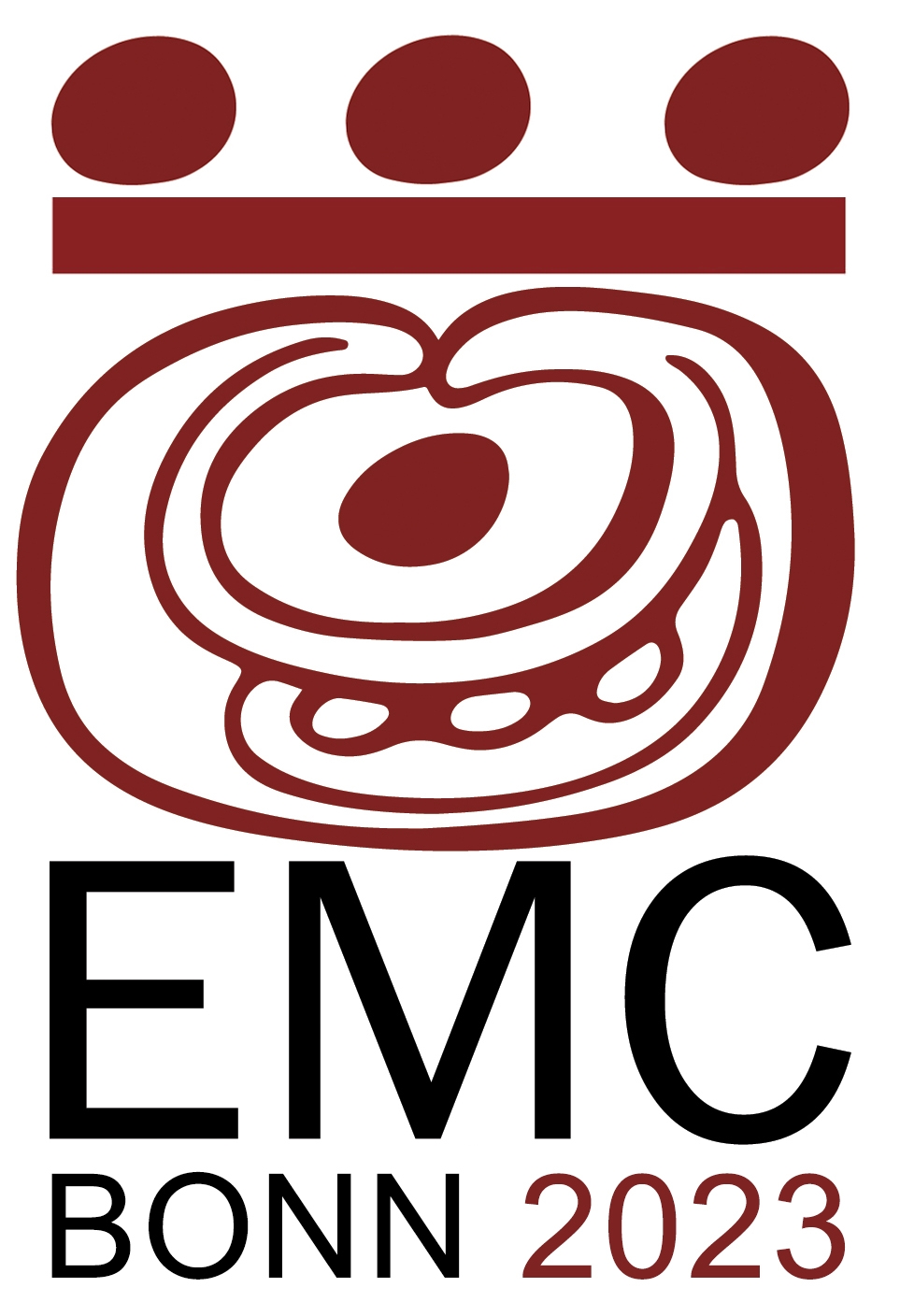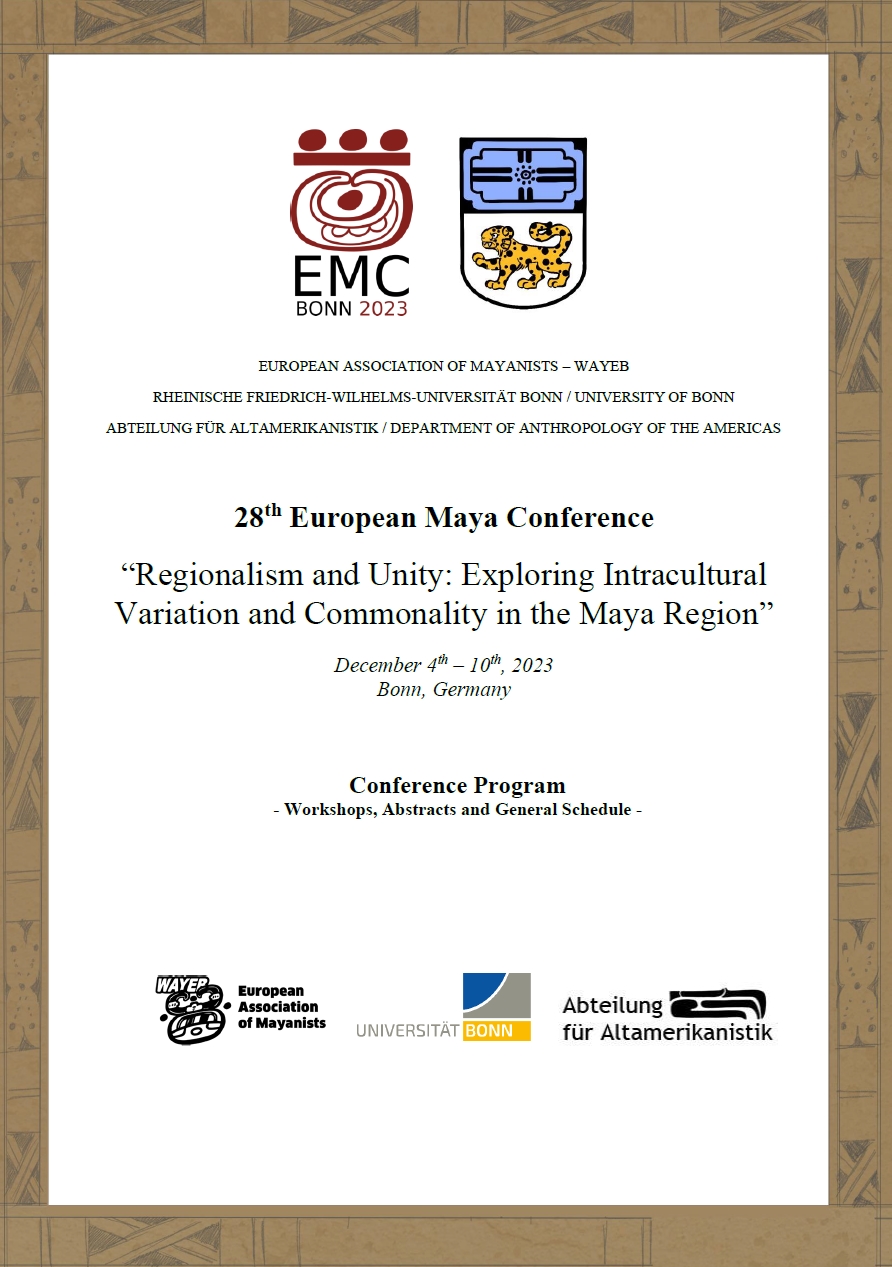und Wörterbuch
des Klassischen Maya



28th European Maya Conference (EMC2023): Regionalism and Unity: Exploring Intracultural Variation and Commonality in the Maya Region
Information
Venue
Workshops: Abteilung für Altamerikanistik, Oxfordstraße 15, 53111 Bonn (#1 on map)
Project and research presentations: Main Building (Hauptgebäude), Uni Bonn, Am Hof 1 or Regina-Pacis-Weg 3, 53113 Bonn, FESTSAAL (#2 on map)

|
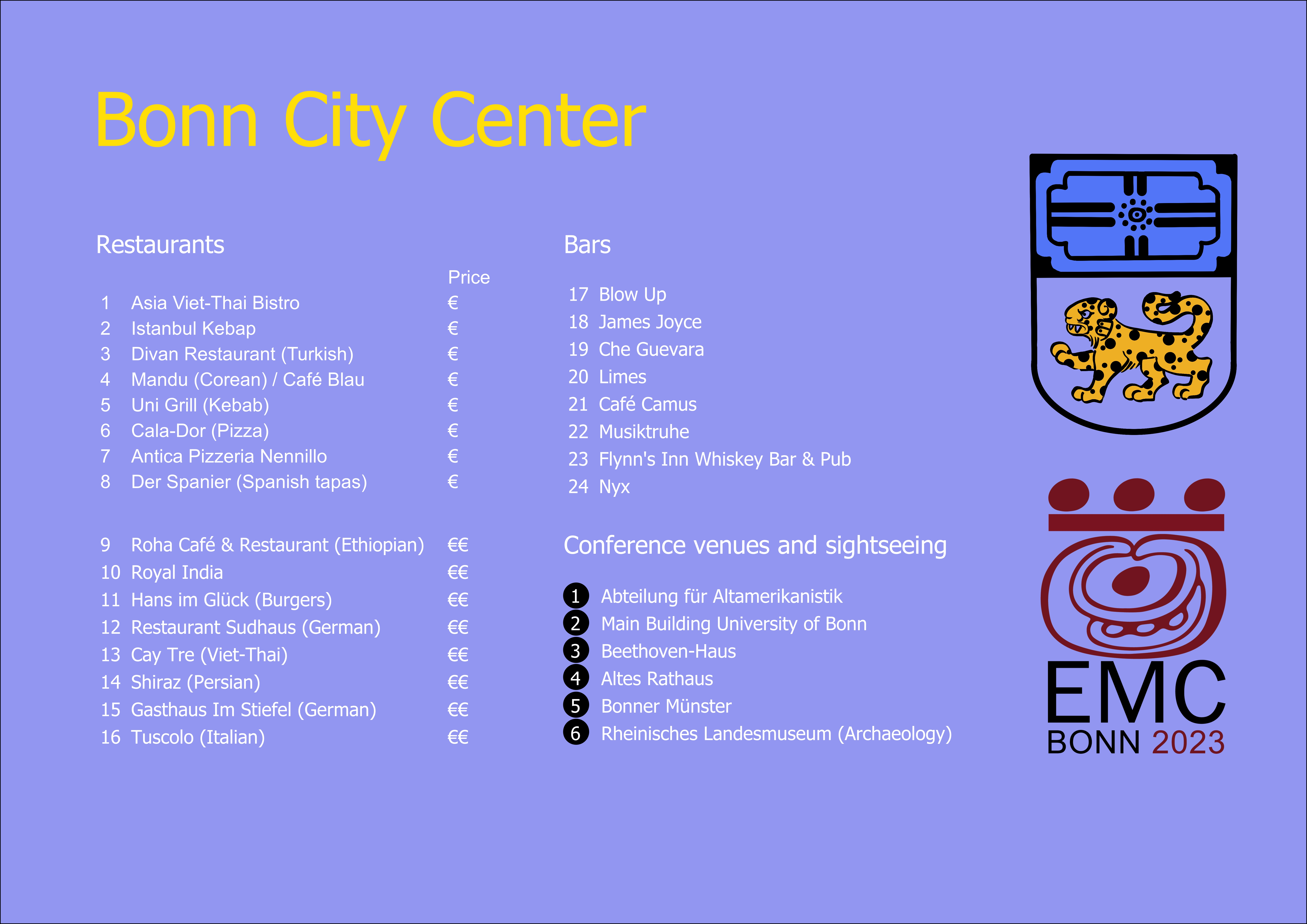
|
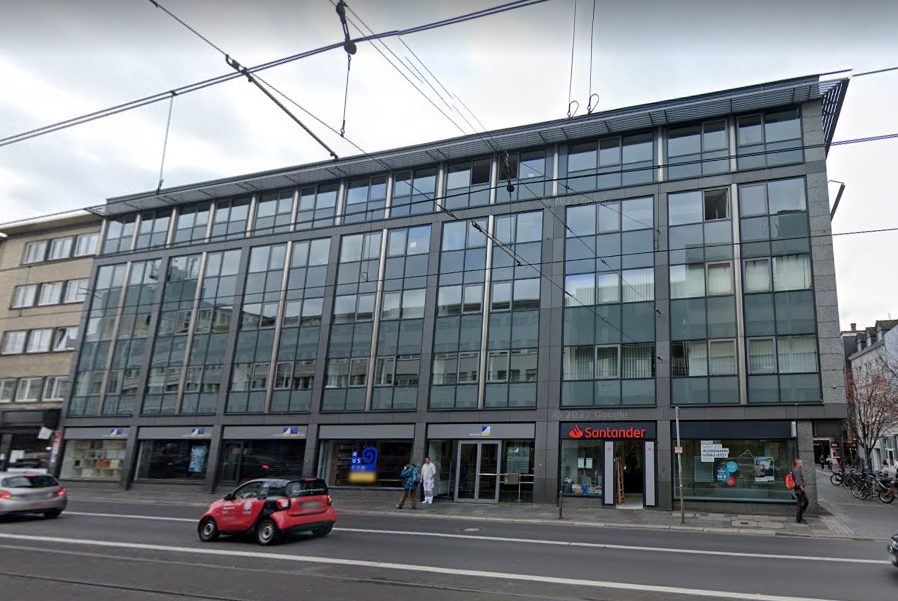
|
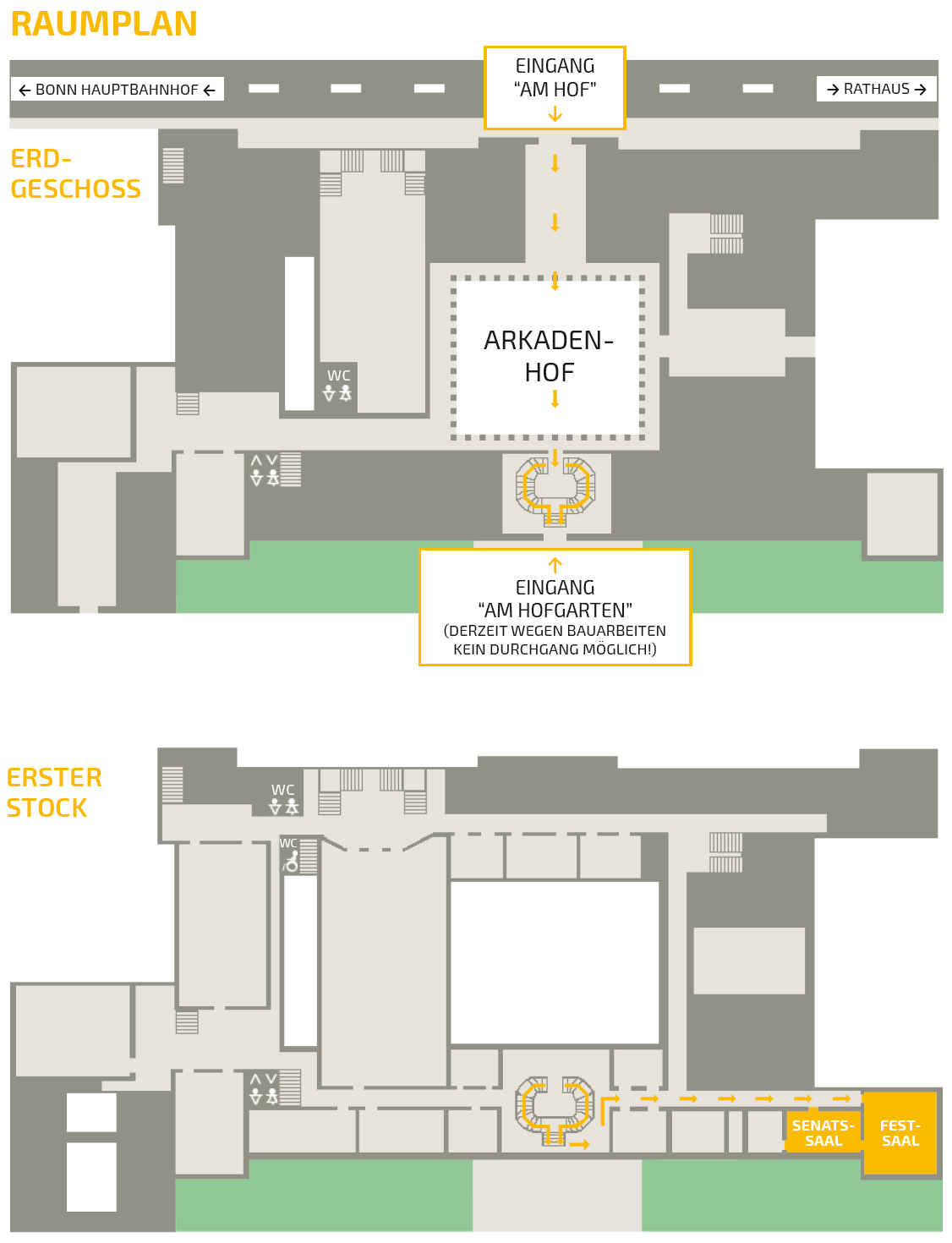
|
Symposium: Hörsaal 2, Campus Poppelsdorf Hörsaalzentrum (CP1-HSZ), Friedrich-Hirzebruch-Allee 6, 53115 Bonn (#7 on map)

|
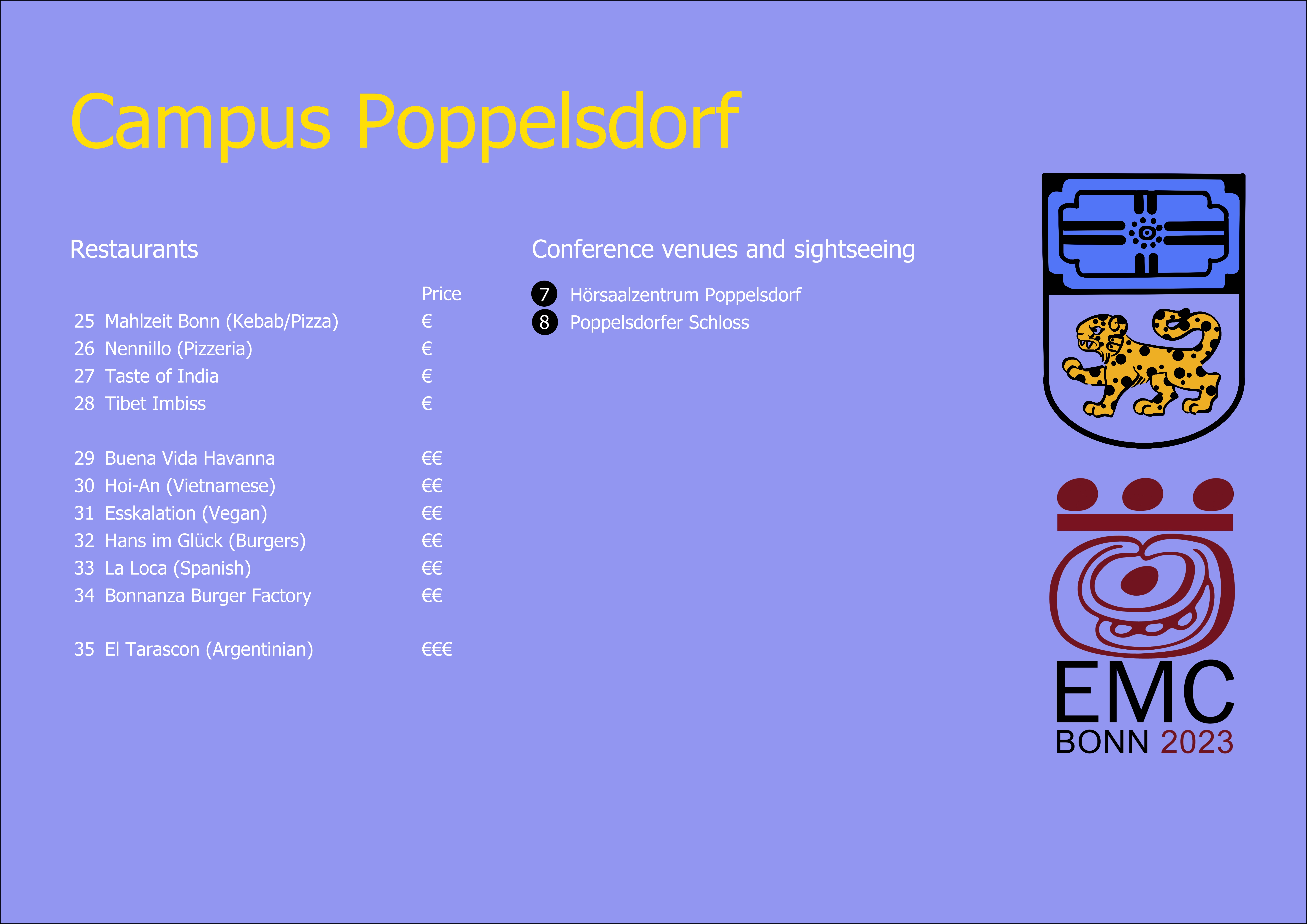
|

|

|
Transportation
Arriving from Cologne / Bonn Airport (CGN)
When arriving at Cologne/Bonn Airport (CGN) and aiming to reach Bonn, you have two convenient options:
Option 1: SB60 Shuttle Bus
- The SB60 shuttle bus operates directly between Bonn Central Station (Hauptbahnhof or Hbf) and Cologne/Bonn Airport.
- Buses run every half hour on weekdays and every hour on weekends.
- Check the bus schedule on the VRS website or their app: https://www.vrs.de/en/.
- The bus stop is located just outside the arrivals terminal at the airport.
- Tickets, priced at 8.80 Euros (general rate), can be purchased from the driver or via the VRS App. Reduced fares are available for students with a valid ID.
- The entire journey takes approximately 31 minutes and is the most convenient way to reach Bonn.
Option 2: Train and Tram Connection
- An alternative route is to take a train and tram combination, but this may be slightly more complex.
- First, head to the airport's train station (underground) and find a train bound for Cologne (Köln).
- From Cologne, take a train to Bonn.
- Alternatively, you can go towards Siegburg/Bonn or Beuel and then transfer to a tram or bus that will take you to Bonn Central Station.
- Example routes include:
- Tram S19 from the airport to Siegburg/Bonn, then transfer to Tram Line 66 (U-Bahn) to reach Bonn Central Station in approximately 46 minutes.
- Regional train RB27 (direction Koblenz) to Bonn-Beuel, then take Bus Line 609 or Tram Line 62 to Bonn Central Station in around 40-46 minutes.
- Regional train RB27 (direction Koblenz) to Cologne (Köln), then find the Regional Express RE5 train to Bonn Central Station in about 50 minutes.
When using the VRS App:
- The airport station is listed as "Flughafen Köln/Bonn Bf, Köln – Flughafen."
- The Central Station of Bonn is referred to as "Bonn Hbf / Bonn Hauptbahnhof."
- Tickets can be purchased within the app, from bus drivers, or at service points. Note that there are no ticket vending machines on trains, so always ensure you have a valid ticket to avoid a 60 euros fine.
Taxis are also available from the airport to Bonn Central Station, with fares typically starting around 60-70 euros (minimum).
For more information, visit: https://www.cologne-bonn-airport.com/en/parking-arrival/bus-rail-services.html
Arriving from Düsseldorf Airport (DUS) to Bonn
Getting to Bonn from Düsseldorf involves a combination of trains and trams, as there are no direct connections. Follow these steps:
1. Reach the airport railway station (Bahnhof Düsseldorf Flughafen) via the SkyTrain.
2. Look for a train heading to Bonn, such as the Regional Express RE5 (direction Koblenz). This train will take you directly to Bonn Central Station in approximately 1 hour and 30 minutes.
3. Purchase your train ticket from the machines in the station or online via the VRS (https://www.vrs.de/en/) or Deutsche Bahn (DB) websites/apps (https://int.bahn.de/en/).
Alternatively, you can use the underground S-Bahn station (Düsseldorf Flughafen Terminal) and take Tram Line S11 to Cologne Central Station (Köln Hbf), which takes about 1 hour and 20 minutes. From there, transfer to a train bound for Bonn, such as RB48 (direction Mehlem Bf) or RB26 (direction Koblenz), to reach Bonn Central Station in approximately half an hour. The total journey from Düsseldorf Airport to Bonn takes around 2 hours and 20 minutes.
Check your connections in advance on the VRS or Deutsche Bahn websites/apps and make sure to purchase a valid ticket to avoid a 60 euros fine if checked on the train.
For more information, visit: https://www.dus.com/en/to-and-from/bus-and-train
Arriving from Frankfurt Airport (FRA) to Bonn
To reach Bonn from Frankfurt Airport (FRA), you can take fast trains (ICE or IC) that pass through the airport's train terminal. Here's how to do it:
1. Follow the signs to the airport's train terminal (Frankfurt(M) Flughafen Fernbahnhof).
2. Purchase your train ticket in advance from the machines in the terminal or online via the Deutsche Bahn app/website (https://int.bahn.de/en/).
3. The journey to Bonn Central Station (Bonn Hbf) typically takes around 1 hour and a half, with possible layovers at Siegburg/Bonn. From Siegburg/Bonn, take Tram Line 66 to reach Bonn Central Station in approximately 25 minutes.
It's important to note that not all fast trains go through the center of Bonn, so you may have a layover/change at Siegburg/Bonn.
Alternatively, you can consider taking a Flixbus from FRA to Bonn. Check their tickets and timetable on their website: https://global.flixbus.com/. Keep in mind that Flixbus stops on the outskirts of Bonn, so you'll need to take a bus or tram to reach the city center.
Local Transport in Bonn
For public transportation in Bonn, we recommend purchasing single tickets or day passes, which range in price from 2.90 Euros to 9.90 Euros depending on the fare zones. Remember to validate your ticket to avoid fines and check the VRS website or app for current fare information and schedules.To use local transport in Bonn, ensure you have a valid ticket, as random checks occur, and fines of 60 euros are imposed for traveling without a ticket. Tickets can be obtained from bus drivers, ticket vending machines at stops (which can be set to English), or online via the VRS website/app (https://www.vrs.de/en/).
In addition to public transport, various micromobility companies, including Lime, Uber, and Nextbike, operate in Bonn, offering alternative transportation options such as bicycles and e-scooters.
Stay informed and prepared when using public transportation to make your journey to and around Bonn hassle-free.
Accomodation (Hotels and Hostels)
Hotels
Bob W Beethoven, Bonngasse 7, 53111 Bonn
https://booking.bobw.co/
Beethoven Hotel Dreesen, Bonngasse 17, 53111 Bonn
https://www.beethovenhoteldreesen.de/
BrauHotel Bonn, Brüdergasse 6, 53111 Bonn
https://www.brauhotel.com/
Achat Sternhotel Bonn, Markt 8, 53111 Bonn
https://achat-hotels.com/hotels/bonn/sternhotel-bonn
Hotel Europa, Thomas-Mann-Straße 7, 53111 Bonn
http://www.hotel-europa-bonn.de
Hotel Aigner, Dorotheenstraße 12, 53111 Bonn
http://www.hotel-aigner-bonn.de/
Hotel Deutsches Haus Bonn, Kasernenstraße 19-21, 53111 Bonn
http://www.deutscheshaus-bonn.de/
Hotel Baden, Graurheindorfer Str. 1, 53111 Bonn
http://www.hotel-baden.de/
Domicil Hotel Bonn, Thomas-Mann-Str. 26, 53111 Bonn
https://www.rugshotel.com/
prizeotel Bonn-City, Erzbergerufer 15, Zentrum, 53111 Bonn
https://www.radissonhotels.com/en-us/hotels/prizeotel-bonn-city
Dorint Hotel Bonn, Berliner Freiheit 2, 53111 Bonn
https://hotel-bonn.dorint.com/
Hotel 83, Sandkaule 3A, Zentrum, 53111 Bonn
http://www.hotel83.de/
Hotel Bonn City, Am Marthashof 1, 53111 Bonn
http://www.hotelbonncity.de/
Hotel Belmont Classic, Oxfordstraße 12-16, 53111 Bonn
https://www.belmont-classic.com/
Hotel Motel One Bonn-Hauptbahnhof, Am Hauptbahnhof 12, 53111 Bonn
https://www.motel-one.com/hotels/bonn/hotel-bonn-hauptbahnhof/
Hotel Motel One Bonn-Beethoven, Berliner Freiheit 36, 53111 Bonn
https://www.motel-one.com/hotels/bonn/hotel-bonn-beethoven/
Hotel Colegium Leoninum, Noeggerathstraße 34, 53111 Bonn
https://www.leoninum-bonn.de/gb
Hotel Mercedes Garni & Appartements, Maarflach 17a, 53113 Bonn
http://www.hotel-mercedes-bonn.de/
IntercityHotel Bonn, Quantiusstraße 22, 53115 Bonn
https://hrewards.com/de/intercityhotel-bonn
Pension Colmant, Colmantstraße 8, 53115 Bonn
https://www.pension-colmant.de/
Tante ALMA's Bonner Hotel, Wallfahrtsweg 4, 53115 Bonn
https://tante-alma-hotels.com/bonn/
President Hotel, Clemens-August-Straße 32-36, 53115 Bonn
http://www.presidenthotel.de/
Hotel Kurfürstenhof, Baumschulallee 20, 53115 Bonn
http://www.kurfuerstenhof-bonn.de/
Budget Hotels
B&B Hotel Bonn-City, Vorgebirgsstraße 33, 53119 Bonn
https://www.hotel-bb.com/de/hotel/bonn-city
Hostels
Hostel 45, Kölnstrasse 45, 53111 Bonn
https://hostel45-bonn.de/
Max Hostel, Maxstraße 7, 53111 Bonn
http://www.max-hostel.de/
BaseCamp Hostel Bonn, In der Raste 1, 53129 Bonn
https://www.basecamp-bonn.de/
Youth Hostel Bonn, Haager Weg 42, 53127 Bonn
https://www.jugendherberge.de/en/youth-hostels/bonn/
General Booking Platforms
https://www.booking.com
https://www.airbnb.de
The Conference
Workshops (December 4th - 8th 2023)
Venue: Abteilung für Altamerikanistik, Oxfordstr. 15, 53111 Bonn (#1 on map)
Keynote lecture (Monday 4 December)
Regionalism and Unity: Exploring Intracultural Variation and Commonality in the Maya Region
Nikolai Grube (Department for the Anthropology of the Americas / Textdatenbank und Wörterbuch des Klassischen Maya, Universität Bonn), Harri Kettunen (University of Helsinki / Wayeb President)
Marie Botzet (Textdatenbank und Wörterbuch des Klassischen Maya, Universität Bonn), Dimitrios Markianos-Daniolos (Textdatenbank und Wörterbuch des Klassischen Maya, Universität Bonn) & Panos Kratimenos (Institute of Archaeology, University College London)
The Beginners’ Workshop will provide a general introduction to Maya epigraphy. It is open to anyone interested in the topic, and is especially ideal for people who have never worked with Maya inscriptions, although people with limited previous experience are also welcome. The workshop will cover various topics, including the history of decipherment, an overview of the corpus, and the inner workings of the writing system itself. Starting from the basics, the participants will learn about the principles of Maya hieroglyphic writing, the Maya calendar, and the structure of texts. Hieroglyphic inscriptions from different Maya cities will be studied, as a means of providing a general picture of the politics, beliefs, and individual actors of the ancient Maya world. By the end of the workshop, the participants will be able to read simple inscriptions, follow calendrical calculations, and identify key historical figures. The workshop will be conducted in English, but individual explanations will also be available in Spanish and German.
Instruction language: English. The instructors are also able to attend questions and comments in German and Spanish.
Admittance: 40 attendees (max.)
Intermediate Workshop (December 5th - 8th)
Regional variation in ceremonial discourse in Classic Maya inscriptions
Advanced Workshop (December 5th - 8th)
Mystery Texts
Nikolai Grube (Department for the Anthropology of the Americas / Textdatenbank und Wörterbuch des Klassischen Maya, Universität Bonn), Christian Prager (Textdatenbank und Wörterbuch des Klassischen Maya, Universität Bonn) & Elisabeth Wagner (Textdatenbank und Wörterbuch des Klassischen Maya, Universität Bonn)
Despite significant advances in deciphering Maya hieroglyphic writing, we can currently comprehend only about 60 percent of the attested over 1000 signs linguistically, whereby only 40 percent are deciphered with absolute certainty. Fortunately, these constitute the most frequently documented signs, allowing us a substantial linguistic understanding and the ability to translate a multitude of hieroglyphic texts. Nevertheless, within the extensive corpus of hieroglyphic inscriptions, we encounter texts that we grasp linguistically, yet their content remains enigmatic to this day. This mystery arises from four distinct factors: 1) certain signs elude decipherment, 2) terms from Classic Mayan are not preserved in modern Mayan languages and hence remain incomprehensible, 3) metaphors are only partially understood, 4) texts are constructed upon ontologies that continue to elude our understanding. In our workshop, we will present a selection of such “mystery texts” from throughout the Maya region to decipher them in collaboration with participants and collectively try to interpret their enigmatic contents.
Instruction language: English. The instructors are also able to attend questions and comments in German and Spanish.
Admittance: 25 attendees (max.)
Special Workshop (December 5th - 8th)
Kaqchikel Maya Culture through the living art of weaving
Ana Lucía Sebaquijay (Universidad de San Carlos, Guatemala) & María Francisca Elías Canás (ENBI Nim Naoj, San Martín Jilotepeque, Chimaltenango, Guatemala / Department for the Anthropology of the Americas, University of Bonn)
El tejer es una antigua técnica de expresión artística y, al mismo tiempo, la materialización de la memoria cultural y de la identidad maya. El tejido maya se remonta a tiempos precoloniales. Su supervivencia en el presente es un testimonio de la creatividad y resistencia de los mayas actuales. En el taller, los participantes se iniciarán en el arte de tejer Kaqchikel y, al mismo tiempo, conocerán aspectos importantes de la cultura Kaqchikel de hoy día. El taller se centra en el manejo del telar y en el aprendizaje de las técnicas básicas de tejido.
Instruction language: Spanish.
Colloquium "Research in the Maya Area and Mesoamerica at the University of Bonn" (December 8, 2023)
Main Building (Hauptgebäude), Uni Bonn, Am Hof 1 or Regina-Pacis-Weg 3, 53113 Bonn, FESTSAAL (#2 on map)
Bonn projects, researchers and doctoral students present current research and results. Download the PDF of the program.
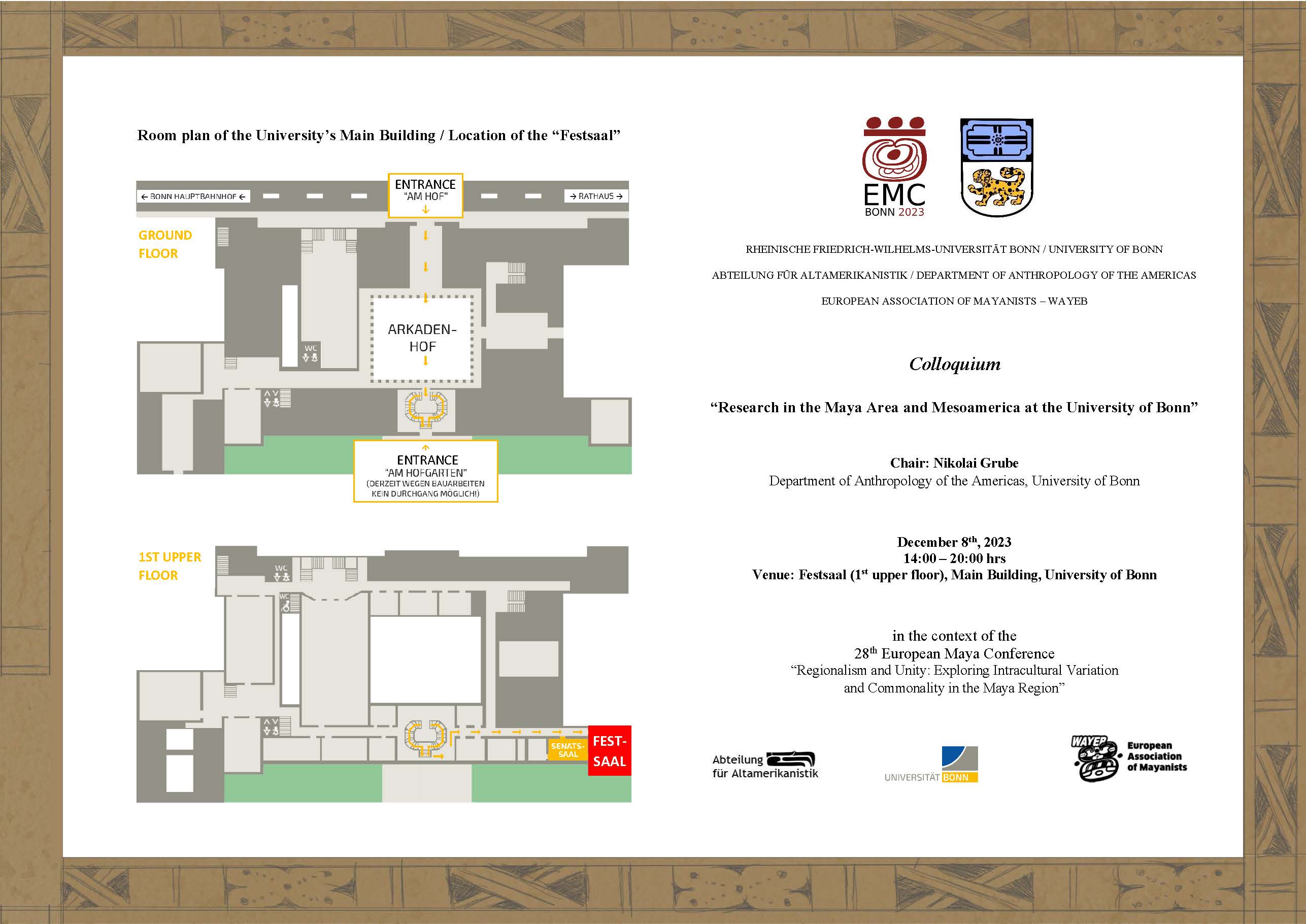
|

|
Symposium (December 9th and 10th)
Campus Poppelsdorf Hörsaalzentrum (CP1-HSZ), Friedrich-Hirzebruch-Allee 5, 53115 Bonn, HÖRSAAL 2 (#7 on map)
List of speakers
Nikolai Grube & Harri Kettunen: Regionalism and Unity: Exploring Intracultural Variation and Commonality in the Maya Region
Juan Carlos Meléndez & Emiliano Ricardo Melgar: Lapidary Variations and Commonalities in Antiquity: An Overview of Ancient Maya Portable Greenish and Bluish Stone Mosaic Masks (CE 300 – 800)
Xin Lin 林忻 & Guo Peng Chen 陳國鵬: The Maya Commons
Catherine Nuckols: Within Arm’s Reach: Scribal Workshops and the Geographic Extent of Eighth-Century Maya Full-Figure Inscriptions
Lorraine A. Williams-Beck: Where an Area is More Than Land: Pre-Columbian Cultural Identity in the Chenes Region
Kathryn Reese-Taylor, Felix A. Kupprat, Armando Anaya Hernández, Debra S. Walker, F. C. Atasta Flores Esquivel, Joshuah Lockett-Harris, Matthew Longstaffe, Véronica A. Vázquez López, Valeria Montserrat Suasa Nuñez, Sophía Gutiérrez Rodríguez, Kyle Farquharson, Nicholas P. Dunning: Regional Identity as Reflected in the Settlement of the Bajo El Laberinto Area
Ivan Šprajc: Astronomical Orientations in the Lowland Maya Architecture: Common Trends, Regional Patterns, and Temporal Variations
Vera Tiesler: Regionalism Versus Unity: Exploring Head and Tooth Crafting Under the Backdrop of Mobility and Cultural Change in the Greater Maya Area
Caitlin Earley & Ulrich Wölfel: Global concepts, local expressions: Regional innovation in Chaculá ceramics and sculpture at the end of the Classic Period
Erin L. Sears: Making Ceramic Mayans within a Highland–Lowland Interaction Zone
Brent K.S. Woodfill: Dynamic Regional Relations and Local Identities at the Highland-Lowland Interface in Central Guatemala
Jarosław Źrałka, Juan Luis Velásquez, Vera Tiesler, Jakob Sedig, David Reich & Dorota Bojkowska: The same or different Maya? Diversity and homogeneity in the Ixil region during pre-Hispanic times
Victor Castillo: Kingdoms of the Highland Maya: A Reappraisal
Iyaxel Cojti Ren: Diversity and Integration in the Maya Highlands during the Late Postclassic Period
Mallory Matsumoto: Water and Baptism in K’iche’an Social Identity: From Postclassic to Colonial
Lolmay García & Brigittine French: Voces múltiples en las memorias históricas de los kaqchikeles y continuidades en procesos históricos de violencia en Guatemala
Kristell Pech Oxte: Formas de lo humano en la literatura maya contemporánea: análisis de obras de la península de Yucatán y Guatemala hacia un rastreo de lo similar y lo diverso en la naturaleza-maya
Nancy Alicia Martínez: Writing with Five Senses: Regional Variations in Contemporary Ts’íib
M. Charlotte Arnauld: Variation in Terminal Classic isthmic connections: Maya cities at the crossroad
Christa Schieber de Lavarreda: Tak’alik Ab’aj, Unidad Regional versus Diversidad local
Oswaldo Chinchilla: The Pacific Coast: Maya or Not?
Jan Szymański, Joachim Martecki & Gabriela Prejs: How Far Is Beyond? Social and Cultural Identities in the Preclassic Western El Salvador and Its Ties with the Maya Area
Philippe Nondédéo: Terminal Classic Occupation at Naachtun, Peten: An Example of Resilience and Sociopolitical Reorganization after Political Crisis
